How To Recover From A Google Algorithm Update
Now if you’re following Google best practices, then theoretically you should be safe from penalisation and your rankings, traffic and sales should improve… But it doesn’t always work like that.
At the time of writing this blog, the Google August 2023 core algorithm update is halfway through its rollout, and things are going well for our clients here at Talk To Media. However, what if that wasn’t the case? What if we’d had a client rankings tank overnight? What’s the first thing we’d do after drawing straws to decide who answers the phone?
Well, our strategy can be broken down into 10 easy to follow steps:
- Make sure the update has finished
- Understand what the update targeted
- Review what pages and content were affected
- Perform competitor analysis to determine who else was affected
- Revisit your content
- Revisit your technical SEO
- Revisit your authority
- Create new, high-quality content
- Diversify your marketing
- Be patient
Let’s dive into a bit more detail shall we…
Make sure the update has finished
The golden rule before making any decisions relating to Google algorithm updates. I can’t count how many times we’ve been at the start of the update, and I’ve panicked after seeing drops, only for those drops to be rectified and rankings improve a week later.
When updates are rolling out, it’s a turbulent time for the search results pages and you don’t want to be making any decisions based on incomplete data.
Updates vary on how long they take to roll out. Most core algorithm updates are completed in 2 weeks, but targeted updates can take as little as 24 hours (part 1 of the June 2021 spam update), or we’ve seen updates roll out for as long as two and a half months (June 2021 page experience update)
How do you know when updates are finished?
There’s no magic secret here, Google keeps their ranking search status page regularly updated with all the updates.
You’re able to see a Summary of the update, the date it began rolling out and how long it took to fully complete.
If the algorithm update hasn’t finished rolling out yet, then you’ll see an Information status.
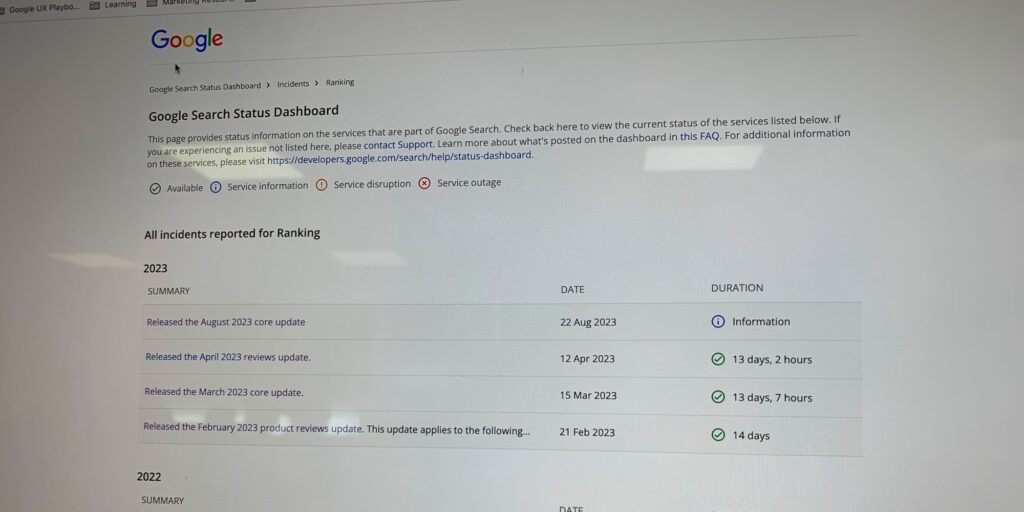
Understand what the update has targeted
Okay so the update has finished, and your rankings are still below where they need to be. The next step is to understand if there’s a specific reason you’ve been affected.
You see there are three different types of Google algorithm updates, core, named and unnamed.
Core updates
Core updates are broad Google updates that affect the entire ranking system across all countries. Google states that there are no specific targets with these updates and that they serve to increase the overall relevancy, accuracy and user experience of the search engine.
The problem this gives us SEOs is how do we go about looking at recovering? Well, if you’re affected by a core update, there’s a high likelihood that Google sees something on your website that goes against their best practices, so it’s a good time to review your content, technical aspects and authority – More on this later.
Named updates
Named updates (we also call them targeted updates internally) are updates that target something specific within Google’s eco-system. For example recently we’ve had the February 2023 product reviews update and the December 2022 link spam update.
Now the positive to named updates is that you know exactly what Google isn’t liking and you can start work to amend your website.
The negative is that these updates are generally used to target black-hat or spammy practices and if you’ve been penalised by one of these, it probably means you need to overhaul your entire strategy.
It’s also worth noting that depending on what update has affected you, rectification can take a long time or may not even be possible without a new way of thinking. The link spam update mentioned above is a great example of this.
Unnamed updates
Unnamed updates (or unconfirmed updates) are updates that Google doesn’t officially announce, but there’s enough chatter about them for SEOs to see that something has changed.
You see Google releases hundreds of updates every year, and only announces the big ones. So, when there’s an unconfirmed update it’s important to gather the data from what people are saying online and try and establish a pattern as to what sites are being affected and why it may be. This will allow you to formulate a strategy that keeps you in Google’s good graces.
A piece of advice here – Make sure there’s enough chatter to warrant reviewing your strategy. People on forums have a tendency to blame Google for their drop in rankings at any chance they get. Big publishes such as Search Engine Journal or Search Engine Land will usually report on unnamed updates when there’s enough sites affected.
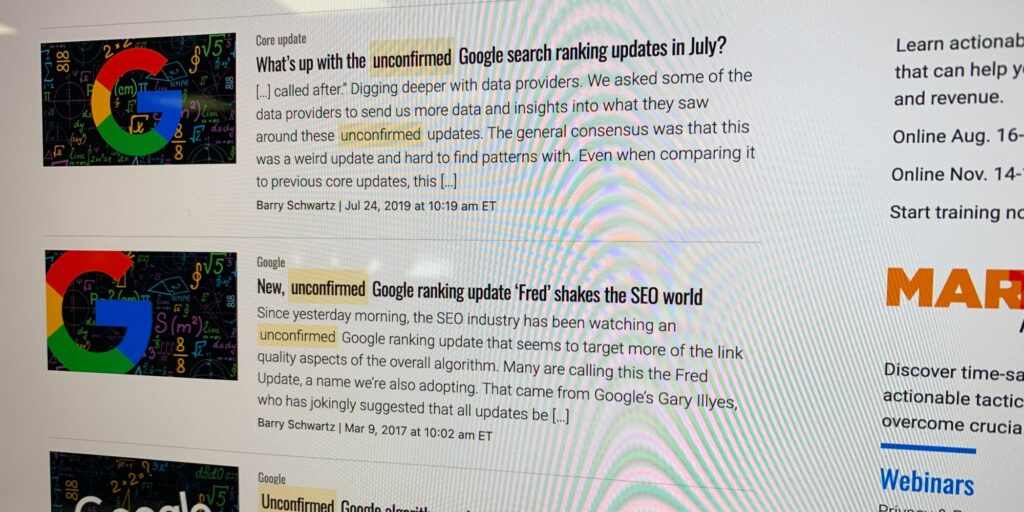
Review what pages and content were affected
For the rest of this blog, we’re going to assume that the update wasn’t a named update, as if it was, you should already know what you need to do to begin fixing your rankings.
The next step for core or unnamed updates is to understand what parts of your site took the rankings and traffic hits. This is so that you can establish a pattern and understand what Google didn’t like about your site.
There are two tools that you’ll need for this section: Google Analytics 4 and Google Search Console.
Google Analytics 4
Google Analytics 4 allows you to see the traffic on your site and filter by organic traffic only. This lets you quickly see drops in traffic, which in turn allows you look further at the page to review it.
It’s important to look past the base traffic stats when using Google Analytics 4. For example, is the bounce rate of the affected page really high? If so, could it be a search-intent mismatch that has been picked up by Google which has caused the ranking drop? (Hopefully so as this is a pretty easy fix and just involves a bit more keyword research).
Google Search Console
Google Search Console is key for looking at why the traffic to your site is down. Is it that your average position has tanked? Is it because your CTR has fallen? Or is it because your overall impressions have dropped?
You’re able to review all these metrics on a very granular level with Search Console, so make sure you take all layers in to account.
We like to work our way down by looking at the metrics through the following filters – Site > Category > Landing Page > Query / Queries.
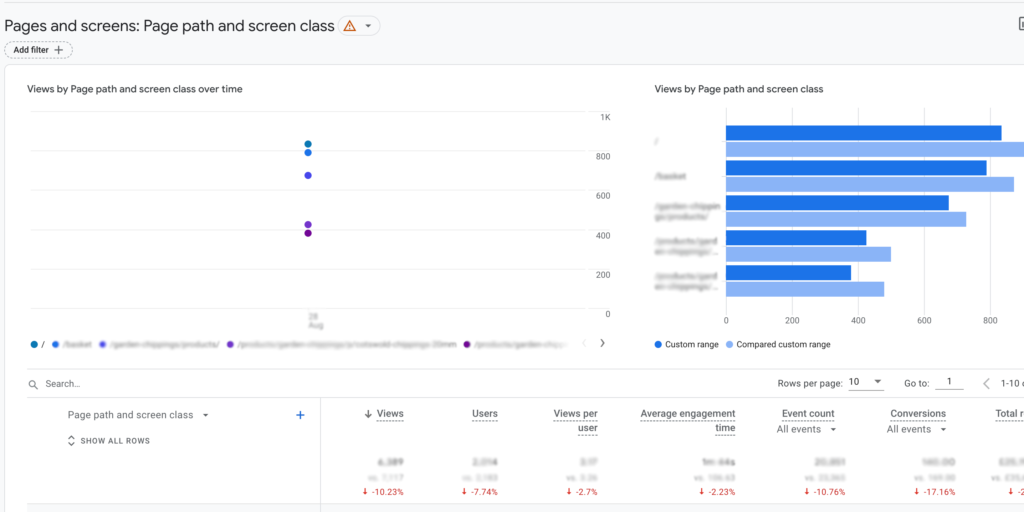
Perform competitor analysis to determine who else was affected
Although it will feel like Google has targeted you specifically, this is more than likely not the case. That’s why it’s always good to take a step back and look at the landscape of the search results. Take a look at who’s new, who’s fallen off and who’s managed to stay put where they were.
This can give you a good idea of patterns and can sometimes provide the answer to why your website has taken a hit.
A recent example of this can be found for one of our nationwide clients who has location-based landing pages to target geographic areas. After an unnamed update we found that any websites that weren’t national or based in the area a user was looking for were removed from page 1… Which makes sense. If you’re searching for a Doncaster marketing agency you probably want a local company or at the least, a national company with a hub here. You’re likely not looking for a Rotherham agency who can service the area.
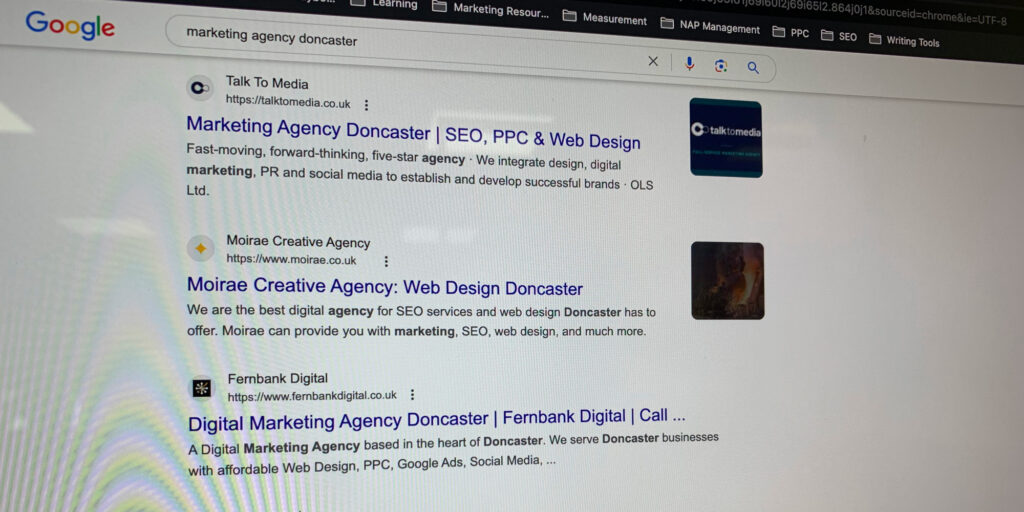
Revisit your content
There used to be a saying in marketing – content is king. In simple terms this meant that the more content you published, the more success you’d have on Social Media and SEO.
Now whilst this used to be true, both marketing channels have advanced massively from the days of content is king. In the modern era of SEO, it’s not enough to publish lots of content. The content that you are publishing needs to be original, high-quality and most importantly, relevant.
This is why the first element of a site that we revisit after an algorithm update is the content. It’s time to take a step back and look at it from a completely unbiased perspective (having someone who doesn’t work on the website day in day out can really help here).
You need to assess a few questions with your content, these are:
Does my content match the users search query intent?
If your content doesn’t match a user’s search query intent, then it doesn’t matter how good you are at copywriting. Not even Shakespeare would be able to rank an informational intent page for a transactional query.
To find out what the intent of a search is, you need to take a look at the website that appear on the search results page.
For example, when you do a search for “how to bake a chocolate cake”, you’ll see recipe articles that give users information on how to bake a cake. This is what’s called informational intent.
So why is it important to know this? Well, if you’re a bakery that’s selling chocolate cakes, then you don’t want to be optimising your page for this query, because you’ll never rank, because you don’t match what somebody wants.
Understand the search intent of your affected pages and make changes where necessary.
Does my content solve the users query better than my competitors?
You might match the intent of the query, but do you really give the users everything they want to know?
For the above example of the chocolate cake search, if you’re leaving out the oven temperature from the recipe then Google’s going to choose articles that supply that information over yours.
When it comes to transactional queries, you need to look at what your competitors promote that you don’t – Do you have all of your awards, USPs, experience and contact details on the page? If not, it’s time to revisit what makes you different and make sure you’re flaunting it!
Is my content original and does it add value?
Nobody wants a search results page full of content that only has a few words changed here and there.
You need to make sure that your content is original and doesn’t just copy what everyone else is saying (this means no Chat-GPT!).
Adding value should be easy, because you should only be writing content about topics you’re knowledgeable about. So, take a look at any hints, tips, tricks or industry insights that aren’t being mentioned and make sure they’re on your webpage.

Revisit your technical SEO
The foundation of any website is its technical structure, and without a good foundation, anything you try to build above will crumble.
We’ve already covered why Google Core Web Vitals is essential for your business, but alongside this, there are plenty of other elements that go into creating a solid website.
It’s important to remember as we discuss these that technical SEO doesn’t just impact how Google sees your website, but putting the time and effort in here also improves your user experience and leads to higher conversion rates for all channels.
Broken elements
There’s nothing worse than getting an error whilst browsing a website. A rogue 404 can completely disrupt a user’s flow and lead them to exiting your website a lot sooner than they should be.
Keeping a close eye on broken links, images and pages help to ensure you can fix these elements before they become a problem for general websites users.
However, when looking at most elements of technical SEO, being proactive is always better than being reactive. Make sure you’ve got internal processes in place for when links, images or pages change so that you can stop the broken elements from appearing all together.
Site speed
Patience is now an idea of the past. If you’re not going to offer users lightning fast speeds, then they know they can go elsewhere and find a company that will.
Google understands this and that’s why they factor site speed into their ranking systems. They measure page speed through a system called Core Web Vitals.
Core Web Vitals is made up of 3 metrics:
- Largest Contentful Paint
- Cumulative Layout Shift
- First Input Delay
If you’d like more information on this topic, check out our blog – Why Google Core Web Vitals is essential for your business.
Meta and heading tags
Coming back to relevancy and matching a user’s search intent, it’s important that you review your meta and heading tags on a regular basis.
Not only does Google use these tags to get a base understanding of what your page should be ranking for and the topics it covers, but potential customers also see these tags on the page and in search results, so it’s important that specific time is dedicated to crafting the best copy possible.
A lot of debate is had around whether it’s worth taking time out of your day to write meta descriptions for individual pages. Our philosophy here at Talk To Media is that our team of skilled copywriters can craft better descriptions that Google’s automated systems, and since we want to give ourselves the best chance of showing the best description – The only way we can do that is by writing individual meta descriptions!
Site architecture
Finally for your technical SEO, make sure you keep an eye on your site architecture.
Now, this element isn’t as important for small brochure sites, however, for e-commerce sites or sites with a lot of sub-services / sub-pages, it’s a key element that is often overlooked.
You need to ensure that important pages are easily reachable from anywhere on the site – This might mean adding new internal links into the header or creating a full internal linking strategy for all pages (e.g., adding a new “related products” section).
A great way to measure how effective your site architecture is, is to perform a crawl depth analysis. This shows how many clicks it takes to get to any given page and allows you to identify weak spots to focus on.
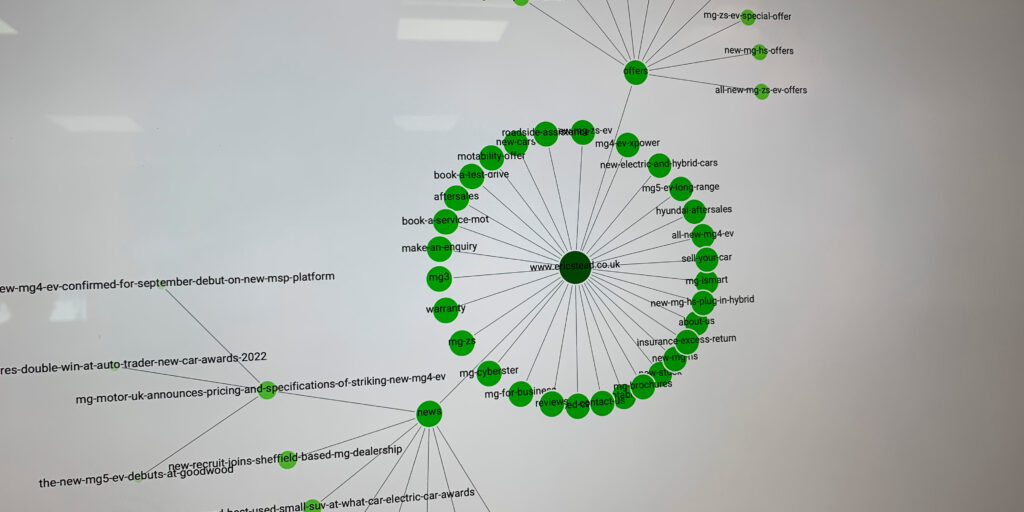
Revisit your authority
Google has one hell of a reputation nowadays. It’s where 96% of the British public go to search for answers and in day-to-day conversation, the company name is used as a verb.
They’ve grown this reputation by only showing the best, most relevant and highest quality websites in their search results.
This means that if you’ve got no online reputation, there’s no way Google are going to show you!
At this point of the review, we begin to look at a company’s online presence, the first point of review is checking the number of backlinks a website has. You see backlinks are like letters of recommendations from one website to another. They’re little messages to search engines that say “yeah, this is a great resource that I don’t mind sending my valuable traffic to”.
A low number of backlinks shows that not many websites trust you, and therefore Google won’t trust you.
To combat this, you’ll need to put a plan in place to increase the number of backlinks your site has. There’s a tonne of way to generate backlinks, including, but not limited to creating helpful content, making sure trade associations link to you and generating newsworthy stories.
After backlinks we check how websites are listed on directories. This might seem a strange one, however, you won’t believe how many times a company has moved office, changed telephone or rebranded and not updated directories.
If Google is seeing different information on your website to what can be found on the wider internet, this is an automatic red flag as their system won’t be able to tell which site they should trust.
Finally, we’ll look at their social presence – Are they on social networks? Do they post regularly? Do these posts get engagement?
Reviewing all of the above can give you a good idea of where you can improve your website’s authority to have Google start looking at you and your business in a more favourable way.
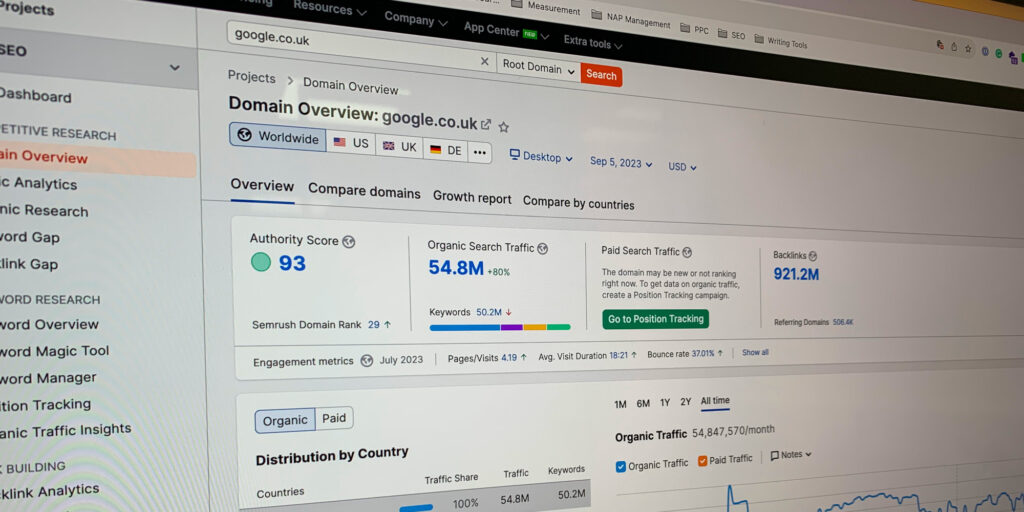
Create new, high-quality content
Ok so you’ve completed a full audit on your website, and you’ve implemented all the fixes identified for issues found… Now what?
Well as the saying goes “If you’re standing still, you’re going backwards” and that really does ring true in the world of SEO.
To ensure your web traffic continues to improve, you need to be creating new high-quality content. This is the time to start looking at your competitors and performing a content gap analysis.
A content gap analysis allows you identify topics that your website doesn’t cover that your competitors are writing about and ranking for. This can expose valuable traffic that you may not have been aware was even there!
Once you’ve performed your audits, it’s important to follow Google best practices for content and not repeat the mistakes that may have got your penalised in the first place. These best practices are fairly simple and mainly revolve around writing content for users, not search engines. Google wants your content to be relevant, useful and easily readable so that they can serve their users the best possible results for their searches.
However, writing content isn’t an easy job. It’s a specialised skill that must be practiced and perfected constantly to avoid writing rust. If you don’t feel comfortable writing the content or feel that you need expert help, then it’s probably worth looking into a content writing service to assist you with the project.
Whilst there will be an upfront cost when producing content this way, the return on investment is usually much higher than writing content yourself, as a better quality of content leads to higher rankings, more traffic and ultimately increased sales. A good content writer can be crucial to your business and can sometimes be the difference between page 1 and page 2 of Google.

Diversify your marketing
Variety is the spice of life – Side note: We’re loving classic sayings today – Think of your marketing as one big cake, lots of different ingredients have to go in to make it successful and just adding lots of one thing is probably going to end in disaster.
We bring this up because no marketing social is ever completely bulletproof. If 90% of your traffic comes organically from Google, then what’s going to happen to your website if Google goes down one day, or a major algorithm update favours other types of sites, or you’re hit with a manual penalty? Spreading your efforts across a range of channels not only allows you to protect your business, but also allows you to connect with customers when they’re in different situations.
So, what other types of marketing compliment SEO well? Let’s take a look…
Google Ads
The obvious place to start. Even if you’re number 1 organically on Google, there’s still going to be up to 4 adverts above you, so why not get in on the mix?
Google Ads works on a pay-per-click basis, so you only pay when a user comes through to your website.
If you’ve got a rock-star SEO strategy, then using your highest converting landing pages on Google Ads can help to mop up any sales that the adverts above you are stealing.
Social Media Advertising
Pivoting to a different channel here, advertising on social media channels such as Facebook, Instagram, X, LinkedIn and Tik Tok allows you to connect with customers as they’re in a more relaxed frame of mind.
Perfect for brand awareness, you can target users based on their interests, behaviours and what they’re talking about.
Keeping your brand current and top of mind is a sure-fire way to ensure that potential customers recognise you when they start searching on Google.
Email Marketing
Email marketing can be a great channel to connect with your existing customer base and promote new products / services to customers interested in learning more about what you do.
The thing to remember when it comes to email marketing is to give users a reason to join your mailing list – Exclusive offers, discounts and early access to new products generally work best – but you’ll have to find what resonates with your customers.
Of course, there are plenty more channels that can be used to bring in new traffic and grow your brand online. Interested in discussing more? Give us a call on 01302 613000.

Be patient
The hardest point to follow from this entire guide… Unfortunately, your site’s recovery isn’t going to be an overnight process, so there’s not really much point in stressing about something you can’t control.
In between implementing all the fixes, generating the new content and testing new marketing channels, ensure you carve out time to relax and unwind. You’re not going to do your best work when you’re stressed so it’s important to keep your head clear and focused on the future, not the past.
It can be a really tough time when your site is hit by an algorithm update, and if you need advice or direction on what to do next, then speak to our team of specialists. We promise that whatever you’re going through, we’ve seen it 100 times before…
About The Author
Matt is a certified Google specialist with over 8 years of experience in Google Ads, SEO + Social Media Advertising.
He holds a certification from and is a member of the Chartered Institute Of Marketing and has presented talks on the importance of using Google Business Profile to boost your local business ranking.
Connect with Matt on LinkedIn today.


